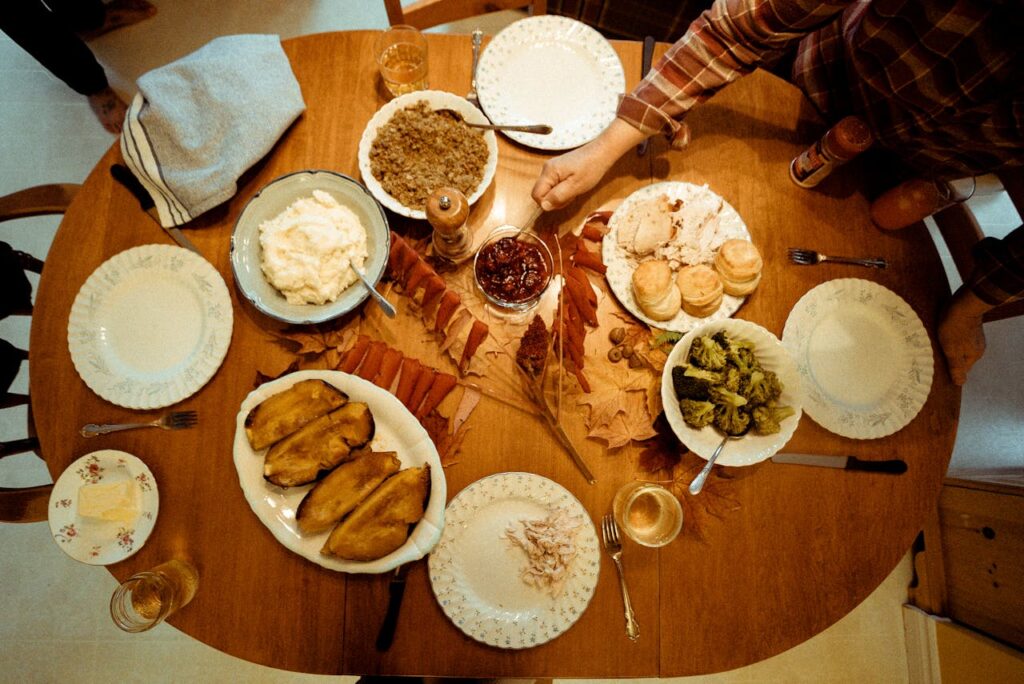Do we need multiple appetizers, representation of every available protein, countless starches, and a dessert table that rivals your local bakery? According to a 2022 article by the University of Minnesota, American families waste roughly 305 million pounds of food from Thanksgiving dinner alone. Whether you’re the host or a guest of an upcoming holiday event, read on for these nine practical tips for planning, prepping, and partying to minimize food waste and make the most of every ingredient before and after your celebration.
Planning
- Know the number. The primary variable when planning to share a meal or a dish is the number of people in attendance. Will there be two people or greater than twenty?
- Consider the type of event and guests who will be attending. Will it be a traditional Thanksgiving dinner or a cocktail party? If you know of any guests’ food allergies (i.e., nuts, dairy, etc.) or preferences, such as gluten-free or low-sugar, keep that in mind when planning the menu. Also, if you’ve been to or hosted this event previously and already know that a particular dish isn’t going to be eaten—I’m looking at you, Waldorf salad Jell-o mold—maybe keep it off the menu this year.
- Use a dinner party calculator. Our favorite is the Guest-imator, a free calculator that estimates how much food you need to keep your guests full and happy. Simply enter the number of “eaters,” indicate how many leftover meals you’d like to end up with (if any), and select the dinner party type. Guest-imator builds menus based on classic dinner parties, smörgåsbord-style, and vegetarian-specific. You’re then prompted to pick which foods will make up your menu (including your own if you choose), and it automatically calculates how much of each ingredient you’ll need. Don’t forget to consider if any of the guests have allergies.
Prepping
- Communicate with your guests. Share your menu ideas and how many will be attending. Discuss your intention to reduce food waste this year, and when appropriate, encourage them to avoid bringing extra servings beyond the guest list. If preferred, allow picky eaters or individuals with food restrictions to bring a meal for themselves to enjoy.
- Make a shopping list—and stick to it. Check your pantry to see if you already have some of the ingredients, and then shop for the rest using a detailed grocery list based on your menu. Avoid impulse buys, especially bulk items that might spoil before use. Brownie points if you can buy fresh, in-season produce, as it lasts longer and cuts down on food miles!
- Save the scraps! Use vegetable scraps to make homemade broth or soup, which you can freeze now and eat later. If you’re making a turkey this year, plan to use every part of it, from bones for turkey stock to drippings for gravy.
Partying
- Get creative with extras. Got extra cranberry sauce or maybe a few extra sprigs of herbs? Stir it into a festive cocktail or mocktail! Mix it with sparkling water, a splash of citrus, and your favorite spirit for a holiday drink that sparkles.
- Right-size your dishware. Be realistic about how much food guests will reasonably consume at the event and plan the dishware accordingly. If items like extra-large dinner plates, salad bowls, bread plates, or extra cutlery or glassware likely won’t be used, save yourself the additional stress and pressure on guests to use them by not putting them out. Bonus: You’ll reduce water waste, too, since they won’t need to be washed!
- Make it easy for guests to take home leftovers. If guests don’t bring their own containers, set out reusable containers (e.g., mason jars) and invite guests to fill them for themselves (or even a neighbor in need) before they leave. Add recipe cards for leftover dishes like turkey chili, casseroles, or pumpkin pie parfaits.
What if the Plan Fails?
Don’t despair if everything doesn’t go as planned! If you end up with more food than can be stored safely, consider these options:
- Donate unopened, shelf-stable items to local food banks or shelters.
- Compost what you can rather than sending it to the landfill, which will reduce methane emissions.
What are YOUR favorite waste-free recipes? We’d love to hear from you! Tag us on Instagram or Facebook!






